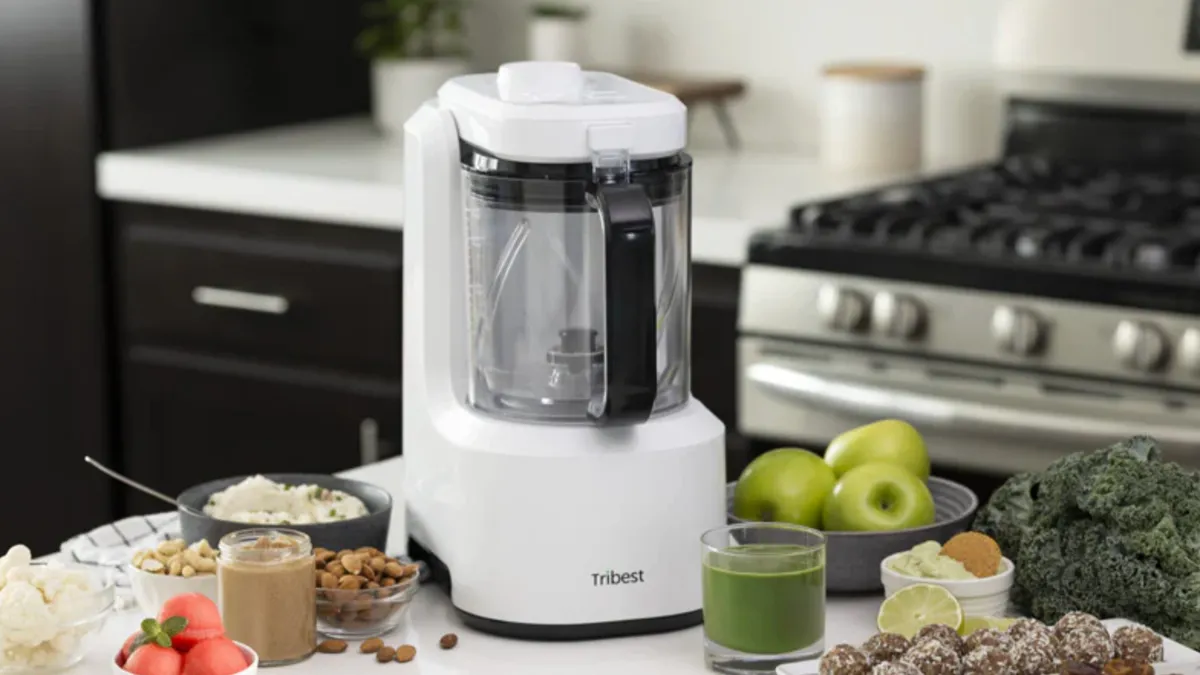
My budget-friendly Oster blender has put in good work over the years, but my ears — always trained to catch useful new technology — perked up when I heard about the Tribest Backspin. The $500 Backspin is a premium blender with a unique contra-rotating design in which blade and canister spin in opposite directions to eliminate scraping and tamping. It also uses a built-in vacuum pump to improve blend quality further (more on that later).
After weeks of testing the Backspin, I found the blender’s novel design, combined with handy automatic presets, makes it easy to use, particularly when pulverizing notoriously stubborn and sticky dips and smoothies.
Don’t miss any of our unbiased tech content and lab-based reviews. Add CNET as a preferred Google source.
My time with the Tribest Backspin revealed that it’s worth the price for those who covet high-tech kitchen gear and consistently great smoothies without the labor. It’s worth noting that the brand is relatively new to the premium blender category, with fewer data points to draw from regarding durability.
Let’s explore why this premium blender was a hit in my home and how it might work for you.
Contra-rotating design allows for hands-off blending
Although the Tribest Backspin is far from the first vacuum blender, it’s the first blender I’ve seen with a contra-rotating design. This means that the Backspin’s blade and canister rotate in opposite directions. One glance at the bottom reveals two sets of motor teeth — metal teeth for the blade and plastic teeth for the container.
Around the spinning chamber is an outer container with a handle and measuring lines. This prevents the spinning portion from becoming a safety hazard and makes it easier to use overall. But having two containers also means using two lids.
Once you attach the inner and outer lids, you’ll lock the whole container in place on the central unit before folding down the top control panel. In addition to hosting the controls, the top panel anchors both lids and stabilizes the inner container as it rotates. It’s also where the built-in vacuum pump connects.
This clever design means the blender can essentially stir itself without you scraping or using a tamper, like with rival blenders. I was skeptical, but automatic blending is easily the best feature of the Tribest Backspin. It was so convenient to load up the ingredients for marinara sauce, including fresh tomatoes from my garden, and let the blender run while I gathered everything I needed for spaghetti.
The Tribest Backspin has three automatic blending presets. Auto is a catch-all mode that blends ingredients for just under 2 minutes, making it great for most scenarios. But you can opt for less blending with Auto Low (about a minute, useful for soft ingredients) or more with Auto High (4 minutes, for tougher foods). There’s also a large dial for adjusting the blending speed, but I hardly touched it with any of the automatic presets.
The other two buttons are Vacuum and Pulse. Hitting the Vacuum button tells the blender to pump out the air before running. It also has a marinate mode, which I didn’t test due to a lack of time.
Read more: You Won’t Find a Better Budget Smoothie Blender Than the Ninja Twisti
Pulse is identical to what you’ll see on standard blenders for chopping nuts and quick bursts to eliminate lumps. I made some great hazelnut meal with around five pulses. Turning this into a mealy cocoa hazelnut spread was by far the most taxing thing I did with the Backspin. (My inexperience with nut butter shows a little here, but at least it tasted great.) While I didn’t experience any issues, I could smell the ozone from the 900-watt motor trying its best.
Vacuum blending bumps the blending quality
The Backspin’s contra-rotation works so well because its vacuum blending feature addresses the tricky problem of cavitation. According to the Science of Cooking, cavitation is an explosive process in which bubbles of gas form due to pressure changes in a liquid moving at high speeds.
Cavitation can be beneficial for obliterating food in a blender. But it can also cause air pockets and shockwaves to form around the blades, reducing their contact with the ingredients you want to pulverize. (Cavitation is also so powerful that it can shatter glass, which is a significant reason for powerful modern blenders using plastic canisters.)
Vacuum blending reduces cavitation by removing air from the blender — pressure changes are now less likely. Another benefit of vacuum blending is that it reduces oxidation in your food, which can help it last longer, preserve flavors and prevent nutrients from breaking down.
While you can use the Tribest Backspin without the vacuum mode (don’t hit the Vacuum button when choosing a preset), I found it extremely helpful in almost every recipe I tested. Aside from a frozen banana that I was too impatient to blend more, everything was remarkably smooth and consistent (e.g., better emulsion): sauces, shakes, smoothies, batters and nut butters.
That said, some flavors benefit from more oxygen. For example, I loved the marinara sauce with minimal cooking. But my wife — who’s not a fan of fresh tomatoes like I am — said it tasted a lot like tomato leaves. Ultimately, I cooked the sauce much longer to break those flavors down into a sauce she didn’t mind.
Tribest Backspin’s complicated design has a few tradeoffs
The smaller inner container lacks a spout and always makes a mess of both containers when pouring out the contents, especially thick liquids. (According to the manual, some liquid leaking into the outer chamber won’t affect the blender’s performance during operation.) Thankfully, the outer container is easy to clean and everything is suitable for the top rack of a dishwasher.
While I like that the blade attaches to the container using a magnet, it’s important to double-check that both attachment points are clean to avoid a bad connection or unwanted microorganism growth. Also, I don’t recommend removing the blade to make it easier to pour things out, since it holds the inner chamber in place and seals the hole at the same container’s bottom. This is a recipe for having the whole thing slide out and making an even bigger mess.
With so many goodies, it’s unsurprising that the Tribest Backspin has a larger footprint than other blenders I’ve used — it takes up more counter and cabinet space on average. But the locking canister makes it easy to carry without pieces scattering, unlike my normal blender. I also appreciate that it has a reasonably long cord compared to my other countertop appliances, so there’s more freedom with where I can put it.
A new design like this won’t get everything right. In my tests, I noticed some wear on the top of the inner lid after it loosened slightly during a long blend. It might be because this particular lid doesn’t have a rubber seal. Besides that, the blade and canisters showed hardly any wear from my 10 blending sessions.
Still, I want to be clear that these design quirks are easy to forgive since they make the Tribest Backspin’s performance and unique features possible. The company may develop better solutions in future models, but I’m impressed that the product engineers balanced the complex design with the needs of everyday cooks.
Should you buy the Tribest Backspin?
The Tribest Backspin’s $500 price tag firmly places it in the premium blender category, so it’s probably not suitable for anyone needing a simple workhorse of a blender for under $100.
Still, the price isn’t as outrageous as premium brands like Vitamix, Blendtec and Breville. It’s also a dynamite option for smoothies, with some of the best results I’ve ever tasted. Ultimately, you decide what works best for your kitchen and budget.



